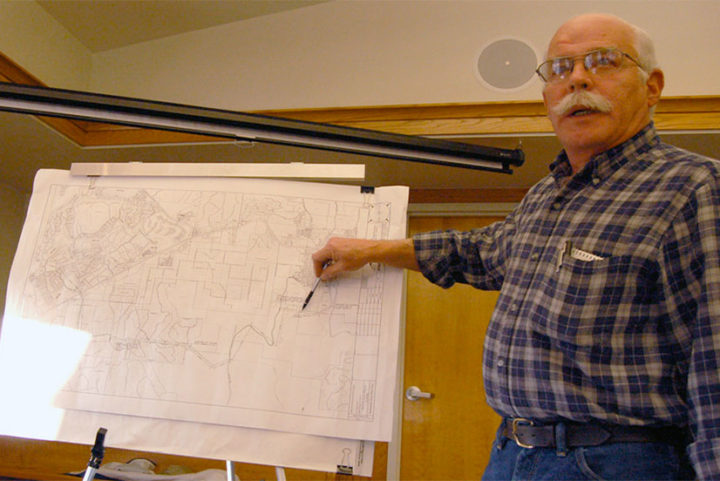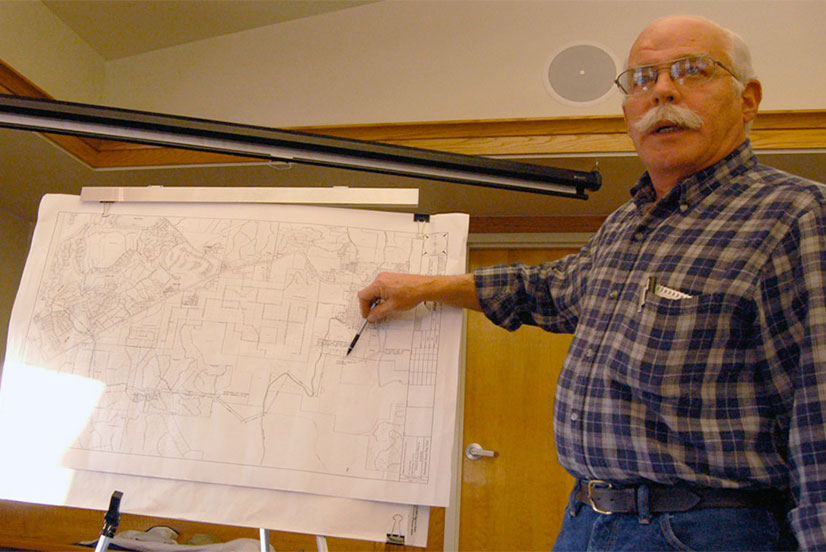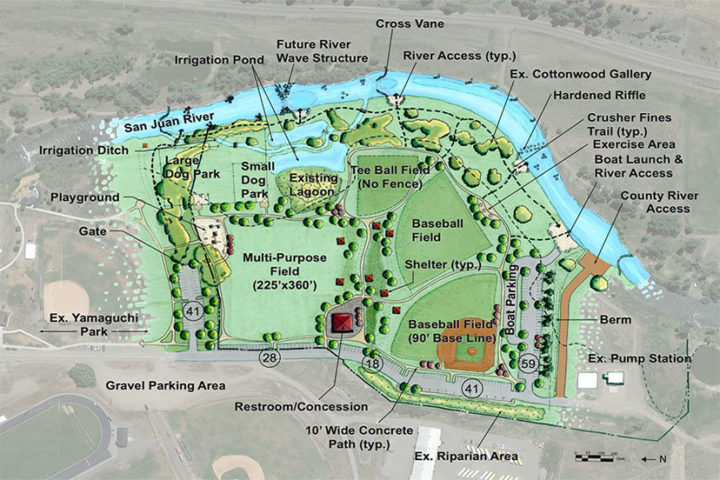On Tuesday evening, the three candidates for the vacant Town Council seat — Gary Williams, Adam Buttons, and Jeff Posey — expressed three different perspectives on the key issues facing our community.
Mr. Williams seems mostly concerned about future wildfires. Mr. Buttons wants to tackle the housing crisis. Jeff Posey spoke about the joys of walking.
None of the candidates mentioned any worries about the Town’s seven-mile-long sewer pipeline.
Later in the evening, Town Council member Maddie Bergon reacted to some unpleasant news about the Pagosa Springs Sanitation General Improvement District: a temporary lack of spare pumps for a system that’s expected to pump 250,000 gallons of sewage per day, uphill to the Vista Waste Water Treatment Plant. The last two Sulzer pumps failed recently, and PSSGID currently has no spare pumps available.
Ms. Bergon:
“And also… kinda of… what’s our communications network? So if there is a failure, how we can communicate with the people in town, and tell them, ‘Hey, we have a problem. And here’s what you can do to help’…
“Like, do not flush, for the next 24 hours.
“What do those communications networks look like? Because that’s something that could be helpful in this situation…”
We’ll consider that question in a moment. But first: How the heck did we get to this point?
As far as I can tell, almost no one working at Town Hall, back in 2011, thought it was a good idea to build a seven-mile sewer line from downtown Pagosa to the Vista Waste Water Treatment Plant. I know for certain that the manager of the Pagosa Springs Sanitation General Improvement District (PSSGID), Phil Starks, was very upset by the pending decision.
Town Manager David Mitchem seemed quite eager to get the project rolling. As did a majority of the Town Council. But maybe not the Town staff?
Pagosa Area Water and Sanitation (PAWSD) District Manager Ed Winton and PAWSD Project Manager Gregg Mayo were also big fans of the project. Mr. Mayo assured us that the PAWSD engineering firm, Kansas-based Bartlett & West, knew exactly what they were doing, and that the project would cost no more than $4 million.
It ended up costing about $8 million. And the bills are still coming in, month after month, as pumps fail while trying to handle the job of moving the waste water uphill, 24/7/365.

PSSGID manager Phil Starks resigned from the Town in 2012, without any kind words to say for the people promoting this project.
David Mitchem is gone. Ed Winton is gone, Gregg Mayo is gone. Bartlett & West are gone.
The Town Council members who voted to spend millions of dollars on this project are gone… except for Mayor Don Volger, who was a Council member at the time.
But the pipeline is still here. Burning up the pumps? And, in terms of annual financing, creating a “structural imbalance”…
From the agenda notes for the Tuesday, October 5, PSSGID Board meeting, the district expects to spend about $1.8 million in 2022… from revenue collections of $1.7 million. Pulling $100,000 from district reserves, in other words.
For the past several years, the District has adopted a budget that must spend into reserves in order to fund capital projects, and in some cases, operational costs. Long term debt service to pay down the pipeline project is also part of the consideration for future expenditures. Due to budget concerns, the district is only able to pursue a limited, phased replacement of collection lines and is delaying large capital projects such as the First Street Bridge lift station project. The District continues to seek opportunities for outside funding, such as grants, to assist in accomplishing these projects.
The Town borrowed millions of dollars to build the sewer pipeline — including a sizable loan from PAWSD. So although the Town now sees the pipeline as a hole in the ground to pour money into — to choose a graphic metaphor — and although the Town would love to hand the whole mess over to PAWSD (the folks who got them into this fiasco in the first place) the chances that PAWSD would want to take over a dysfunctional and expensive pipeline are rather slim.
The Town Council and staff are aware of why PAWSD would be reluctant.
Here’s Council member Nicole Pitcher:
“I just feel like this is the very definition of ‘incrementalism’ — this pump project. And I realize there’s not a ‘resale’ value for what was built, in any kind of holistic way; there’s no way for us to get out of this.
“But it’s kind of like what [Council applicant Gary Williams] said a little bit earlier this evening. How can we develop real estate downtown, if there’s no way to pump sewage uphill? Should we just put a stop to the Yamaguchi South plans and turn them back into sewer lagoons?”
The Council recently approved a $15 million plan to develop baseball fields and other recreation amenities on the 26-acre parcel where the Town previously operated its outdated sewer treatment lagoons.
Yes, the lagoons were outdated, and were located in a flood plain. But they worked, without burning up $50,000 pumps, month after month.
Ms. Pitcher:
“I don’t know. It’s hard to not keep throwing $50,000 after $50,000 at this problem… because I don’t know what our other options are. But…”
Apparently, the current option is to purchase and install eight brand new, custom-designed pumps from a new company — Pentair-Fairbanks — at a cost of about $800,000.
The company is offering a 5-year warranty on the motors, Public Works Director Martin Schmidt told the Council. He didn’t say anything specifically about the other crucial parts of the Pentair-Fairbanks pumps.
But… what about that communications network?
Am I going to get a call in the middle of the night, telling me not to use my bathroom? Because I do use it, sometimes, in the middle in the night.
Town Manager Andrea Phillips:
“So, we would work with the Emergency Management Office at the County, and get alerts out through Nixle, and through the media and everything, too.”
Archuleta County partnered with Nixle a few years back, to implement a Community Notification System, to alert residents in real-time about localized emergency situations and relevant community advisories. You can sign up for these citizen alerts at the bottom of this County web page:
https://www.archuletacounty.org/569/Citizens-Alert
It might help you sleep easier. It does, for me.



